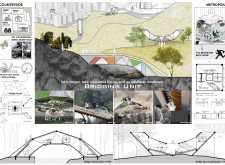5 key facts about this project
The core of this project is its structure, which features a bridging element that connects varying landscapes, creating a physical and conceptual link between urban and rural spaces. The layout includes flexible interior configurations, providing areas for sleeping, leisure, and workspace. Each space is designed to maximize comfort and usability, making it suitable for a range of activities. The architectural elements are strategically placed to ensure ample natural light, increasing the overall livability of the unit.
The unique approach of the Bridging Unit lies in its mobility. Designed to be relocated, this project addresses contemporary challenges such as population shifts and natural disasters. This adaptability differentiates it from conventional housing projects. The integration of a tiered structure mimics the natural landscape, which not only makes the unit more visually appealing but also enhances its functionality in various terrains.
Materiality plays a significant role in this design. The use of sustainable materials such as wood, steel, glass, and high-performance composites underscores a commitment to environmental considerations. These materials are selected not only for their structural integrity but also for their aesthetic contribution, creating an inviting atmosphere. The polygonal geometry adds visual interest and symbolizes inclusivity, making the project accessible and welcoming.
This architectural design emphasizes community-centric solutions, fostering social interactions and collaboration. By incorporating mixed-use spaces, the project allows for diverse functions, encouraging individuals to engage with the environment and each other. The Bridging Unit serves not only as a place for shelter but also as a catalyst for community building.
For those interested in exploring the architectural aspects further, reviewing the architectural plans, sections, and concepts will provide deeper insights into the design and functionality of the Bridging Unit. Understanding these elements will reveal the thoughtful considerations that underpin this innovative project.























